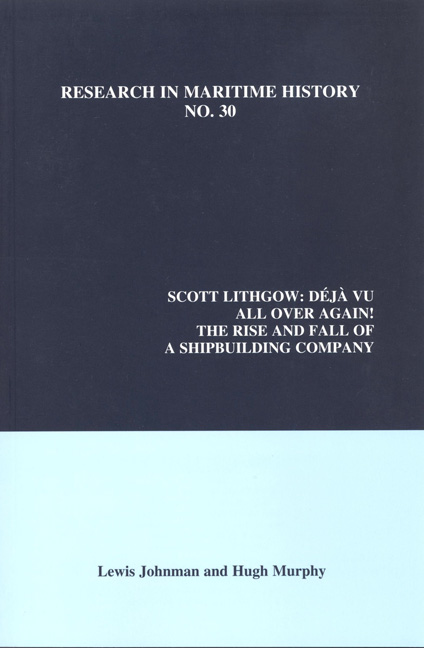Book contents
- Frontmatter
- Contents
- Acknowledgement
- Introduction
- Chapter 1 Scotts of Greenock, 1711-1945
- Chapter 2 Russell and Company to Lithgows Limited, 1874-1945
- Chapter 3 Scotts Shipbuilding and Engineering, 1945-1965
- Chapter 4 Lithgows Limited, 1945-1965
- Chapter 5 The Long March to Merger, 1965-1970
- Chapter 6 The Road to Nationalisation, 1970-1977
- Chapter 7 Nationalisation to Privatisation, 1977-1984
- Chapter 8 Déjà vu All over Again: Trafalgar House, 1984-1988
- Chapter 9 Conclusion
- Appendix
- Bibliography
Chapter 6 - The Road to Nationalisation, 1970-1977
- Frontmatter
- Contents
- Acknowledgement
- Introduction
- Chapter 1 Scotts of Greenock, 1711-1945
- Chapter 2 Russell and Company to Lithgows Limited, 1874-1945
- Chapter 3 Scotts Shipbuilding and Engineering, 1945-1965
- Chapter 4 Lithgows Limited, 1945-1965
- Chapter 5 The Long March to Merger, 1965-1970
- Chapter 6 The Road to Nationalisation, 1970-1977
- Chapter 7 Nationalisation to Privatisation, 1977-1984
- Chapter 8 Déjà vu All over Again: Trafalgar House, 1984-1988
- Chapter 9 Conclusion
- Appendix
- Bibliography
Summary
By 1970 the long campaign by Scotts and Lithgows to avoid being sucked into a single Clyde group while remaining on the MoD (N) list of surface warship builders had ended temporarily. Although a change of government could have an impact, no guarantee existed that these issues had gone away. At the close of business on 31 December 1969, when the remaining legal problems of novating existing shipbuilding and engineering contracts had been resolved, the shipbuilding and engineering assets of Scotts and Lithgows were transferred to seven specially-created operating (1969) companies already incorporated in Scotland. The arrangements to merge these into one holding company, Scott Lithgow Limited, which had already been incorporated in September 1967, did not occur until 6 February 1970. Scott Lithgow Limited was not the ultimate holding company; that honour belonged to Scotts Shipbuilding and Engineering Company Limited, which on 6 February held sixty percent of the shares. This amounted to 500,000 participating preference shares of £1 each and 1,000,000 ordinary shares of £1 each, with Lithgows holding 1,000,000 ordinary shares only. In addition to the 1,500,000 shares held in Scott Lithgow Limited, Scotts retained two vessels built on its own account on bareboat charter and its half share in Scott Lithgow Drydocks Limited, which was not part of the merger. Scotts was now primarily an investment company, as was the case with Lithgows Limited. But it is with Scott Lithgow Limited and to a lesser extent its operating companies that we are primarily concerned.
The underlying philosophy behind the merger had already been explained in detail in ¿he first edition of the Scott Lithgow House Magazine nine months earlier by Scott Lithgow's chairman, Michael Scott, and its vice chairman, Sir William Lithgow. In an interview Scott explained that the merger was not a “shotgun marriage,'’ but that both he and Lithgow were only prepared to join forces if they could retain their respective firm's individualities, expertise and names. Moreover, they were “most certainly not going to run ourselves as a single massive organisation…with all the departments under one roof and all our yards under detailed control.” To support his view, Scott stated “that the men, who design and build a submarine are not the people to build a tanker, so why push them together?”
- Type
- Chapter
- Information
- Scott LithgowDéjà Vu all over again! The Rise and Fall of a Shipbuilding Company, pp. 207 - 256Publisher: Liverpool University PressPrint publication year: 2005



